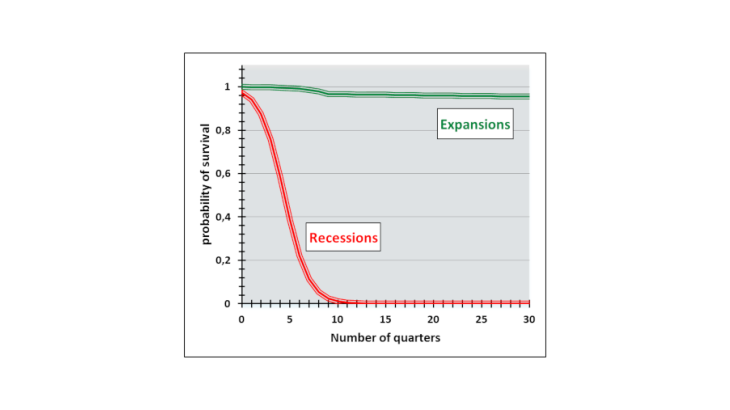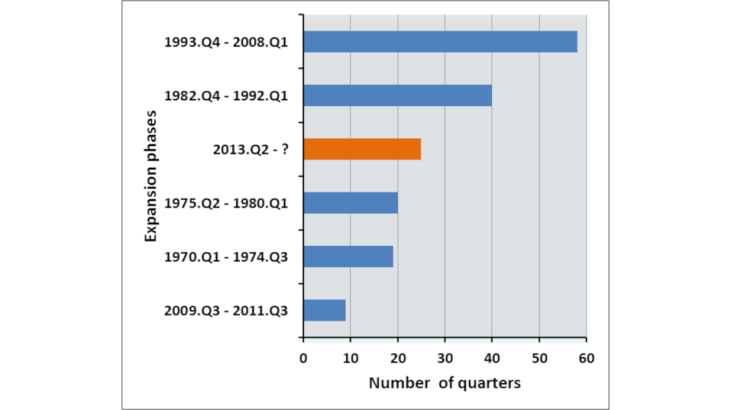In 2019, the euro area entered its seventh consecutive year of growth, with average annual GDP growth of around 1.8% since mid-2013. Does the protracted nature of this expansion cycle mean that is becoming increasingly fragile? Is a downturn imminent?
No, according to Janet Yellen at the last annual meeting of the American Economic Association: “I think it’s a myth that expansions die of old age. I do not think that they die of old age. So the fact that this has been quite a long expansion doesn’t lead me to believe that…its days are numbered”, to which Ben Bernanke jokingly replied: “I like to say they get murdered.” This view is based in particular on the work of Diebold and Rudebucsh (1990), who studied the duration dependence of the US business cycle in terms of the time elapsed since the World War II.
Others believe however that it does. In a post published on VoxEU, Franck Portier shows, using US data, that for an expansion that has lasted for only five quarters, the probability of entering a recession in the next year is around 10%. This probability increases to 30-40% if the expansion has lasted for over 35 quarters. According to these results, expansions are therefore assumed to die of old age. The business cycle could be likened to the human life cycle: ageing inevitably leads to an end to the cycle, a phenomenon also known as senescence.
However, the results of these studies are based solely on US data and are therefore not necessarily transferable to the euro area economy.
De Bondt and Vermeulen (2018) have recently studied the question of the duration dependence of business cycle phases for all G7 countries and demonstrate that the duration of German expansions depends on their age, but that this does not appear to be the case for France and Italy. However, this study has two limitations. First, the classification of expansion and recession phases is obtained from their peak and trough dates calculated by the Economic Cycle Research Institute (ECRI). This classification is therefore not directly derived, in a probabilistic manner, from the statistical model used. Second, only 3 of the 19 euro area countries are studied, which does not make it possible to obtain a result for the euro area economy as a whole.
Euro area economic expansions do not die of old age...
This paper tests the assumption of the time-dependence of euro area business cycle phases by applying the “duration dependence” method developed by Durland and McCurdy (1994) to the euro area's real GDP growth rate from 1970 to the present day (aggregated before 1999). These authors develop a statistical model to capture and distinguish, in a probabilistic manner, the expansion and recession phases over time, while taking into account the potential dependence of each phase on its duration. It is therefore important to determine whether euro area data allow a strong statistical link to be established between the probability of switching from one phase to another and the age of the current phase.
Naturally, the method used is not perfect. First, the model uses only an economic indicator and does not take into account a vast swathe of data relating to the state of the economy. Second, although similar to modern macroeconomic models, the statistical system does not take account of the vulnerabilities that develop during expansion phases (such as the excessive build-up of debt) which are likely to trigger an economic downturn. This method cannot therefore replace traditional macroeconomic projection exercises.
Chart 1 shows the probability of transition and thus reflects the probability of survival of each phase in relation to its age. An expansion phase’s probability of survival clearly appears to be independent of the number of quarters already survived by the phase. This probability is close to 0.95 after two years and remains constant thereafter. The occurrence of a recession therefore does not depend on the age of the current expansion. Old economic expansions are as likely to disappear as new ones. However, recessions are more likely to "grow old". The model shows that beyond one year, recessions have a one-in-two chance of disappearing and giving way to a new cycle. Beyond a year and a half, their chance of survival appears to be even less than 20%.

